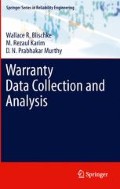Abstract
This chapter discusses the nonparametric approach to the analysis of 1-D warranty data. It explains the nonparametric approach to inference based on the distribution function, renewal function, mean cumulative function, etc., in the context of 1-D warranty data. The estimators depend on the data structures and scenarios discussed in Chap. 5. The chapter deals with the nonparametric approach to deriving estimators for the above quantities based on different data scenarios for the three data structures. Examples using data sets from Appendix F are given to illustrate the methodology.
Access this chapter
Tax calculation will be finalised at checkout
Purchases are for personal use only
Notes
- 1.
These quantities are discussed in Chap. 3, Appendix A, and C. The objectives or goals for analysis are discussed in Sect. 1.6.1.
- 2.
The EDF discussed in Sect. 8.5.1 is based on the nonparametric approach.
- 3.
Some properties of this estimator are discussed in [2], p. 549.
- 4.
A distribution function is said to be arithmetic if its support is on {0, ±d, ±2d, …} for some constant d and otherwise is said to be non-arithmetic, [6].
- 5.
- 6.
Discussed in Sect. 11.3.1.
- 7.
- 8.
Estimation of the survival function for censored data also given in Sect. 8.5.1.
- 9.
- 10.
The set contains counts of the items working and of the number uncensored just prior to t (k).
- 11.
- 12.
SPLIDA (S-Plus Life Data Analysis), see, www.public.iastate.edu/~splida.
- 13.
In MINITAB, use Stat ℧ Reliability/Survival ℧ Nonparametric Growth Curve.
- 14.
See MINITAB for details and use Stat ℧ Reliability/Survival ℧ Distribution Analysis (Arbitrary Censoring) ℧ Nonparametric Distribution Analysis.
- 15.
See Sect. 5.12.2 for a graphical view of Structure 2 data.
- 16.
See Chap. 8 for more on plotting procedures.
- 17.
See Sect. 8.5 and Appendix C.
- 18.
This will be investigated further in Chap. 12 by fitting parametric distributions to the data.
- 19.
The survfit function computes an estimate of a survival curve for censored data using either the KaplanᾢMeier or the Fleming and Harrington method and computes the predicted survivor function for a Cox proportional hazards model.
- 20.
For more information, see [4], S-plus (www.insightful.com), and R-language (http://cran.r-project.org).
- 21.
If necessary, the unit “month” can be easily substituted with “week”, “day” and so on [8].
- 22.
See Sect. 5.12.3 for more details of Structure 3 data.
- 23.
Chapter 9 gives general definition and derivation of confidence intervals.
- 24.
Chapter 15 presents a graphical representation of MOPᾢMIS plot.
- 25.
In some cases it can be a shift, if a company operates more than one shift per day.
- 26.
The MOPᾢMIS tables may be of different forms; see Table 11.10 for another form.
- 27.
The detailed data that are required to calculate WCR2(i) for all production months are not given in the book.
References
Aalen O (1976) Nonparametric inference in connection with multiple decrement models. Scand J Statist 3:15ᾢ27
Blischke WR, Murthy DNP (1994) Warranty cost analysis. Marcel Dekker, New York
Blischke WR, Scheuer EM (1975) Calculation of the cost of warranty policies as a function of estimated life distributions. Nav Res Logist Q 22:681ᾢ696
Fleming T, Harrington DP (1984) Nonparametric estimation of the survival distribution in censored data. Commun Statist 13(20):2469ᾢ2486
Frees EW (1986) Nonparametric renewal function estimation. Ann Statist 14:1366ᾢ1378
Frees EW (1986) Warranty analysis and renewal function estimation. Nav Res Logist Q 33:361ᾢ372
Frees EW (1986) Estimating the cost of a warranty. J Bus Econ Statist 6:79ᾢ86
Kalbfleisch JD, Lawless JF, Robinson JA (1991) Methods for the analysis and prediction of warranty claims. Technometrics 33:273ᾢ285
Kaplan EL, Meier P (1958) Nonparametric estimation from incomplete observations. J Am Statist Assoc 53:457ᾢ481
Lawless JF (1982) Statistical models and methods for lifetime data. Wiley, New York
Lawless JF, Nadeau C (1995) Some simple robust methods for the analysis of recurrent events. Technometrics 37:158ᾢ168
Meeker WQ, Escobar LA (1998) Statistical methods for reliability data. Wiley, New York
Meeker WQ, Escobar LA (2005) SPLIDA (S-Plus Life Data Analysis). www.pulic.iastate.edu/~splida
Nelson W (1969) Hazard plotting for incomplete failure data. J Qual Technol 1:27ᾢ52
Nelson W (1972) Theory and application of hazard plotting for censored survival data. Technometrics 14:945ᾢ966
Nelson W (1982) Applied life data analysis. Wiley, New York
Nelson W (1988) Graphical analysis of system repair data. J Qual Technol 20:24ᾢ35
Nelson W (1995) Confidence limits for recurrence dataᾢapplied to cost or number of product repairs. Technometrics 37:147ᾢ157
Nelson W (1998) An application of graphical analysis of repair data. Qual Reliab Eng Int 14:49ᾢ52
Nelson W (2008) Repair data set of: how to graph, analyze, and compare. Encyclopedia of statistics in quality and reliability. Wiley, New York
Thomas DR, Grunkemeier GL (1975) Confidence interval estimation of survival probabilities for censored data. J Am Statist Assoc 70:865ᾢ871
Turnbull BW (1974) Nonparametric estimation of a survivorship function with doubly censored data. J Am Statist Assoc 69:169ᾢ173
Turnbull BW (1976) The empirical distribution function with arbitrary grouped, censored, and truncated data. J Royal Statist Soc 38:290ᾢ295
Author information
Authors and Affiliations
Corresponding author
Rights and permissions
Copyright information
© 2011 Springer-Verlag London Limited
About this chapter
Cite this chapter
Blischke, W.R., Rezaul Karim, M., Prabhakar Murthy, D.N. (2011). Nonparametric Approach to the Analysis of 1-D Warranty Data. In: Warranty Data Collection and Analysis. Springer Series in Reliability Engineering. Springer, London. https://doi.org/10.1007/978-0-85729-647-4_11
Download citation
DOI: https://doi.org/10.1007/978-0-85729-647-4_11
Published:
Publisher Name: Springer, London
Print ISBN: 978-0-85729-646-7
Online ISBN: 978-0-85729-647-4
eBook Packages: EngineeringEngineering (R0)

